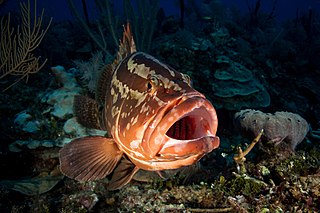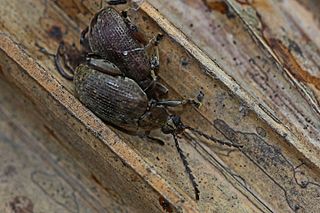The music of the Bahamas is associated primarily with Junkanoo, a celebration which occurs on Boxing Day and again on New Year's Day. Parades and other celebrations mark the ceremony. Groups like The Baha Men, Ronnie Butler,Kirkland Bodie and Twindem have gained massive popularity in Japan, the United States and other places. Other popular Bahamian artists include Stileet and Stevie S.

The Nassau grouper is one of the large number of perciform fishes in the family Serranidae commonly referred to as groupers. It is the most important of the groupers for commercial fishery in the West Indies, but has been endangered by overfishing.

Zamia is a genus of cycad of the family Zamiaceae, native to North America from the United States throughout the West Indies, Central America, and South America as far south as Bolivia. The genus is considered to be the most ecologically and morphologically diverse of the cycads, and is estimated to have originated about 68.3 million years ago.

A blue hole is a large marine cavern or sinkhole, which is open to the surface and has developed in a bank or island composed of a carbonate bedrock. Blue holes typically contain tidally influenced water of fresh, marine, or mixed chemistry. They extend below sea level for most of their depth and may provide access to submerged cave passages. Well-known examples are the Dragon Hole and, in the Caribbean, the Great Blue Hole and Dean's Blue Hole.

The Caribbean reef shark is a species of requiem shark, belonging to the family Carcharhinidae. It is found in the tropical waters of the western Atlantic Ocean from Florida to Brazil, and is the most commonly encountered reef shark in the Caribbean Sea. With a robust, streamlined body typical of the requiem sharks, this species is difficult to tell apart from other large members of its family such as the dusky shark and the silky shark. Distinguishing characteristics include dusky-colored fins without prominent markings, a short free rear tip on the second dorsal fin, and tooth shape and number.

The Caribbean pine is a hard pine species native to Central America and the northern West Indies. It belongs to subsection Australes in subgenus Pinus. It inhabits tropical and subtropical coniferous forests such as Bahamian pineyards, in both lowland savannas and montane forests.

Pseudophoenix is a genus of palms which is native to the wider Caribbean. Three species of the four species are endemic to Hispaniola, while the fourth, P. sargentii, is widely distributed in the northern Caribbean, Florida, and the Yucatán Peninsula.

The permit is a game fish of the western Atlantic Ocean belonging to the family Carangidae. Adults feed on crabs, shrimp, and smaller fish.

Pithecellobium is a genus of flowering plants in the family Fabaceae. It includes approximately 23 species from the tropical Americas, ranging from Mexico to Peru and northern Brazil, including the Caribbean Islands and Florida.

Ctenosaura similis, commonly known as the black iguana or black spiny-tailed iguana, is an iguanid lizard native to Mexico and Central America. It has been reported in some Colombian islands in the Caribbean Sea and Pacific Ocean, and has been introduced to the United States in the state of Florida. The largest species in the genus Ctenosaura, it is commonly found in areas such as grasslands and forests.

Ficus aurea, commonly known as the Florida strangler fig, golden fig, or higuerón, is a tree in the family Moraceae that is native to the U.S. state of Florida, the northern and western Caribbean, southern Mexico and Central America south to Panama. The specific epithet aurea was applied by English botanist Thomas Nuttall who described the species in 1846.

Lysiloma latisiliquum, commonly known as false tamarind or wild tamarind, is a species of tree in the family Fabaceae, that is native to southern Florida in the United States, the Bahamas, Cuba, southern Mexico, and Belize. Its wood is sometimes traded as sabicu wood.

Lysiloma is a genus of flowering plants belonging to the family Fabaceae.

Exelastis pumilio is a moth of the family Pterophoridae. It has worldwide tropical distribution, including Argentina, Brazil, Colombia, Costa Rica, Cuba, Ecuador, Guadeloupe, Jamaica, Mexico, Puerto Rico, Suriname, Japan, Micronesia, South Africa the Virgin Islands as well as Queensland and New Guinea.
Exelastis montischristi is a species of moth in the genus Exelastis known from Hispaniola, Ecuador, Grenada, Jamaica, Martinique, the Virgin Islands, Florida and Texas. It has also been recorded from Tanzania.
Exelastis rhynchosiae is a species of moth in the genus Exelastis, known from Arkansas and Florida in the United States. It is restricted to specific habitats with dry or well drained sandy soils such as pine flatwoods, pine-turkey oak sandhills, sandy open areas of high live oak hammocks, or sand pine-evergreen scrub on ancient dunes where the hostplants grow.

Ernodea is a genus of flowering plants in the family Rubiaceae. All species are small shrubs endemic to the Caribbean region, with most species restricted to the Bahamian Archipelago.

Caryobruchus gleditsiae is a species of beetle in the family Chrysomelidae. It lives in North and Central America and develops inside the seeds of palm trees. Adults grow to a maximum length of 11 mm (0.43 in), the size depending on the size of the seed it grew up in. The species was first described by Carl Linnaeus in his 1763 Centuria Insectorum.

The brown garden eel, also known simply as the garden eel, is an eel in the family Congridae. It was described by Albert Günther in 1870. It is a tropical, marine eel which is known from the eastern and western Atlantic Ocean, including Madeira, the Canary Islands, Senegal, the Bahamas, the Florida Keys, the Caribbean, Mexico, Belize, Honduras, and Brazil. It dwells at a depth of 10–60 m, most commonly between 20 and 60 m, and leads a nonmigratory, benthic lifestyle, inhabiting reefs in colonies. They likely spawn during the warm season. The larval state of development lasts for about 6–8 months. Adult males can reach a maximum total length of 51 centimetres.

Terminalia buceras is a tree in the Combretaceae family. It is known by a variety of names in English, including bullet tree, black olive tree, gregorywood, Antigua whitewood, and oxhorn bucida. It is native to Mexico, Central America, the Caribbean, and northern South America. It is commonly found in coastal swamps and wet inland forests in low elevations.
















